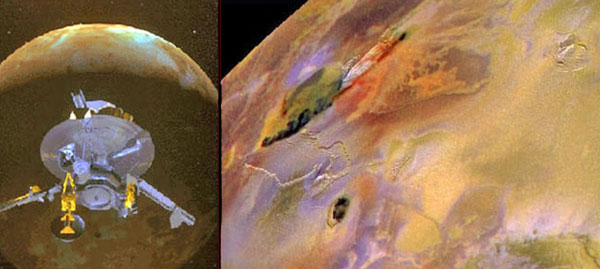|

by David Talbott
from
Thunderbolts Website
Dec 15,
2004

Credit:
NASA/JPL
The most compelling
advances in scientific theory come from successful prediction, and
over the past 25 years the Jovian system has provided a
laboratory in space for testing the predictive ability of the “electric
universe”.
After the Voyager probes revealed surprising “volcanic”
activity on Jupiter’s moon Io, plasma
researchers had an opportunity to anticipate what a closer look
might reveal. That closer look came with the sophisticated
Galileo probe, launched in 1989 and reaching the Jovian
system in 1996. In anticipation of new and higher-resolution
photographs and measurements, Wallace Thornhill, following
the lead of Cornell astrophysicist Thomas Gold, and
plasma scientists Anthony Peratt and A J Dessler,
registered these claims in advance of Galileo’s arrival:
-
the vents of the
"volcanic" plumes will be much hotter than lava
-
the plumes are
the jets of cathode arcs, and they do not explode from a
volcanic vent but move around and erode the periphery of
dark areas (called "lava lakes" by planetary
geologists)
-
the "lava
lakes" themselves are merely the solid surface of
Io etched electrically by cathode arcs and exposed
from beneath the sulfur dioxide "snow" deposited by
continuous discharge activity. Therefore, they will not
reveal the expected heat of a recent lava flow.
Each of these
predictions received stunning confirmation by the Galileo
probe. The spacecraft measured the temperatures of Io’s
"volcanic" hot spots and gave readings, averaged over
a pixel, that were hotter than any lava on Earth — in
fact, too hot to be measured by Galileo’s instruments.
As predicted by Thornhill, the discharging was discovered to
be focused on the edges of the so-called "lava lakes”, though
the rest of these dark fields are comparatively cold. None of the
expected volcanic vents could be found. Rather, the plumes of the "volcanoes"
are actually moving across the surface of Io, an
exclamation point being provided by the plume of Prometheus
which, in the years since Voyager,
has moved
more than 80 kilometers.
Much to the astonishment of mission scientists, it was discovered
that the "volcanic" plumes emit ultraviolet
light, something inconceivable under normal conditions of
volcanic venting. Ultraviolet light is, of course,
characteristic of an electric arc. It is why arc welders wear
darkened welding masks!
|

